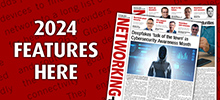11 May 2021

The strategy will see the city use data and technology to change how different departments in the council operate, and how they work together to deliver services across Hull.
One area of focus is how the Street Team responsible for traffic planning and management, use data to make more informed decisions on how to manage traffic and people flows around the city, determine bus routes and cycle paths, but also work more closely with the authority’s Planning Team.
For instance, in the past, planning decisions for new buildings have been based on models using a combination of data and hypotheses on aspects such as traffic flows and parking. While modelling has reached a high standard and can make sound predictions, it is still a model and not always a true reflection of what will happen.
The strategy recognised therefore that using real-time passenger traffic data on how, when and where people come into, move around and exit the city, would not only help the Street Team better shape the road network, parking facilities, and anticipate potential pressure points, but also avoid detrimental planning decisions.
Giving both teams the capability to interrogate the data would help them better understand and anticipate the impact of their decisions. For instance, the Street team would be able to spot pinch points and change the flow to keep people moving at rush hour or on match days, but also advise of areas that are a ‘no-go’ for the Planning Team.
Similarly, the Planning Team could refer to more accurate analysis when assessing a planning application and make a decision with confidence that any impact a development would have would be positive or could be managed. And in instances where this is not the case, they could provide guidance on how the planning application needs to be refined.
Working with Citi Logik, experts in the field of traffic management in smart cities, the council has developed a technology plan to make this vision a reality.
Over the coming years it will build a Smart City Platform, which will integrate all the data the city holds and make it accessible across departments and more widely to the public and other NGOs like universities for example. What’s more it will use artificial intelligence to make highly accurate real-time predictions and assessments using data from across the city so the teams can better manage the challenges they face and make more strategic decisions.
One aspect of the strategy is to consider smarter traffic management. As such, the council has implemented Citi Logik’s Citi Analytics application, a web-based tool that helps cities understand traffic congestion and people movement using internet of things data, such as mobile network information from Vodafone and other IoT data sources including real-time GPS data from vehicles, and cellular data from pedestrians.
The tool is capable of processing billions of data events a day so that journey times, and traffic volumes can be understood and better managed. For instance, traffic jams could be predicted 15 minutes before they happen, and traffic re-routed to avoid it materialising at all. Crucially, the data is depersonalised so it can be used by organisations without risk.
Citi Analytics also provides access to easy to build and use real-time dashboards, as well as reporting and accurate modelling. This has made the application quick to implement at Hull Council, with minimal disruption to staff, and fast to deliver results. Now traffic and planning teams can interrogate the data and get meaningful insight on a scale that’s not been possible before.
The council’s strategy also reflects a need to improve the management of air pollution so, a collaborative programme has been put in place to improve monitoring pollution levels, using funding from Innovate UK. The intention is to bring together experts from the council, and Future Cities Catapult, a government supported centre for the advancement of smart cities, with Citi Logik technology to calibrate Real Time Air Pollution data against the nationally released air pollution data. The data will be included in the Citi Logik app, and it is hoped that this will allow planning teams to compare the data with real time transport information. They will then be able to make decisions at both the strategic and citizen level.
Citi Logik’s solution also includes pollution monitoring. So, by using data captured on Citi Logik sensors placed around the city, the Council can calibrate the information received from DEFRA sensors and build an accurate and complete view of the pollution levels. In the future this will help the teams report on pollution, see patterns and take the right action to manage traffic and planning changes in real-time.
Ian Anderson, director of legal services and partnerships at the Hull City Council, says that the adoption of Citi Logik’s Analytics software supports the implementation of the city’s smart city vision:
“Our Smart Digital Strategy is ambitious and brings together multiple initiatives. There are not many examples where a city has taken time to build a viable plan to transform how services are delivered cohesively. It is therefore important to have the support of a company with the skills and understanding to translate available big data into a form that is both comprehensible and useable in the context of traffic management and planning. Citi Logik’s heritage in this field is invaluable.”
Ian adds that Citi Analytics is supporting delivery of the vision on a number of levels: “The Citi Analytics solution provides the city with real time data in relation to the flow of traffic along main routes into and through the city and the ability to interpolate that with the real time impact on air pollution. It also provides the data analytical tools to understand the origin and destination of journeys into the city, for both normal daily travel and major events, supporting longer term transport and city planning, which will be essential as we move towards implementing the city’s separately procured Smart City Platform.”










